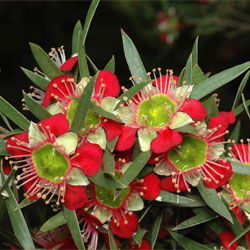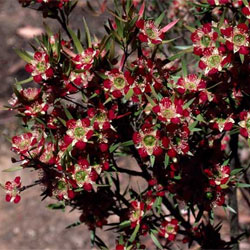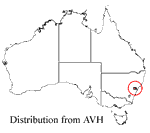Leptospermum spectabile
 |
 |
Colo River Tea Tree
Leptospermum spectabile Joy Thomps.
Leptospermum spectabile is part of the large, predominantly southern plant family Myrtaceae which includes members such as the iconically Australian genus Eucalyptus. The constituents of the genus Leptospermum are commonly known as tea-trees due to the aromatic foliage exhibited by certain species along with their use by early settlers as a tea substitute. In total this genus has 83 species of which 79 are endemic to Australia. Although the genus Leptospermum is itself wide spread the species L. spectabile is in fact geographically very restricted, being found naturally only amongst the rocky soils between the sandstone boulders of the Colo River in the Blue Mountains of New South Wales.
 Leptospermum spectabile is an erect shrub that grows to a rarely exceeded maximum of 3 m high by 2 m wide. Its narrow-elliptical leaves of 2-3.5 cm long by 3-5 mm wide give its overall foliage a neat appearance and allow the plants to be used as a feature. However, the most conspicuous and horticulturally desirable feature of this species is its striking red flowers that reach 2.5 cm in diameter. These flowers can be seen generally in the late spring from generally October to November.
Leptospermum spectabile is an erect shrub that grows to a rarely exceeded maximum of 3 m high by 2 m wide. Its narrow-elliptical leaves of 2-3.5 cm long by 3-5 mm wide give its overall foliage a neat appearance and allow the plants to be used as a feature. However, the most conspicuous and horticulturally desirable feature of this species is its striking red flowers that reach 2.5 cm in diameter. These flowers can be seen generally in the late spring from generally October to November.
Overall this species is relatively easy to grow as it is usually very hardy, and although it will grow in most soil types and sunlight levels, for maximum success this species should be grown in well-drained soils and a sunny position. If given these conditions and a “normal” rainfall regime the plant will respond well with a high degree of frost tolerance down to and including -9°C.
Propagation of this species is generally easily done from both seeds and cuttings, and once established the plant should require minimal maintenance. However, tip or heavier pruning of Leptospermum species after flowering has been shown to improve their vigour and avoid a woody appearance.
Other possible limitations to cultivation of this spectacular plant include the susceptibility of many Leptospermum species to a variety of insect pests. The susceptibility of L. spectabile is still somewhat unknown and current pest control techniques can effectively remedy most pest attacks. Finally, its current paucity in cultivation due to its rareness is a limitation. This however is hopefully a temporary problem, as this attractive species is likely to become very popular in future cultivation.
Text by
Mason Campbell (2005 Student Botanical Intern)
Derivation of the name: Leptospermum spectabileLeptospermum - a Latinized Greek compound; leptos meaning slender and sperma meaning seed. spectabile - Latin from spectare meaning to watch or look at, and abile meaning to have the ability; alluding to the spectacular red flowers. |
References
Harden, G.J. (ed) (2002). Flora of New South Wales. Revised Edition Volume 2. University of New South Wales Press Ltd.
Thompson, J. (1989). A revision of the genus Leptospermum (Myrtaceae), Telopea , 3(3): 301-449.
Wrigley, J. and Fagg, M. (1996). Australian native plants - propagation, cultivation and use in landscaping (4th edition). Reed Books, Kew (Victoria).
Wrigley, J. and Fagg, M. (1993). Bottlebrushes, Paperbarks, and tea trees - and all other plants in the Leptospermum alliance. Harper Collins publishers, Sydney.
![An Australian Government Initiative [logo]](/images/austgovt_brown_90px.gif)

